The Intel Haswell-E CPU Review: Core i7-5960X, i7-5930K and i7-5820K Tested
by Ian Cutress on August 29, 2014 12:00 PM ESTCPU Benchmarks
The dynamics of CPU Turbo modes, with both Intel and AMD, can cause concern during environments with a variable threaded workload. There is also an added issue of the motherboard remaining consistent, depending on how the motherboard manufacturer wants to add in their own boosting technologies over the ones that the CPU manufacturer would prefer they used. In order to remain consistent, we implement an OS-level unique high performance mode on all the CPUs we test which should override any motherboard manufacturer performance mode.
HandBrake v0.9.9: link
For HandBrake, we take two videos (a 2h20 640x266 DVD rip and a 10min double UHD 3840x4320 animation short) and convert them to x264 format in an MP4 container. Results are given in terms of the frames per second processed, and HandBrake uses as many threads as possible.
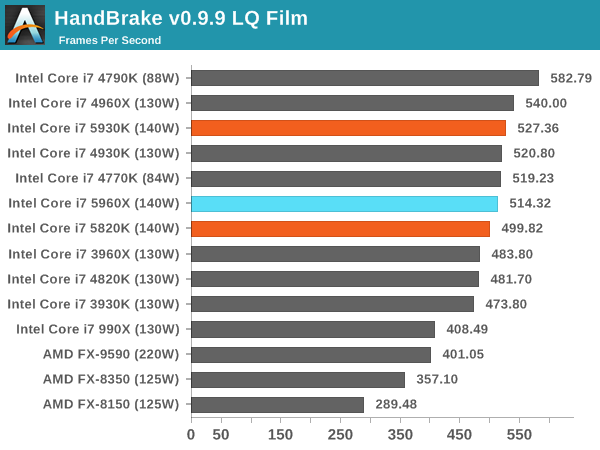
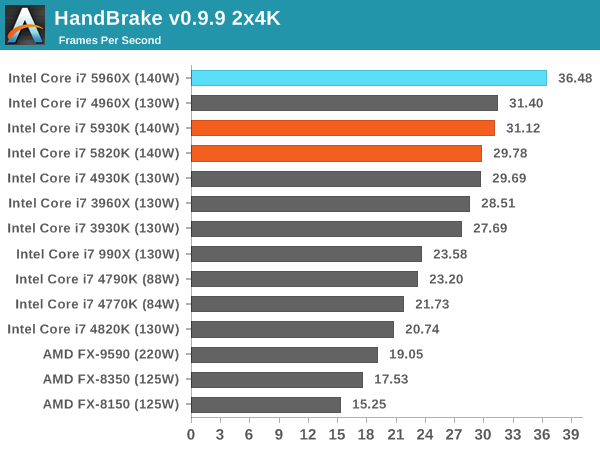
The variable turbo speeds of the CPUs results in a small difference in low quality conversion, and the high single core frequency of the 4790K wins there. For 4K conversion the problem becomes more parallel and the extra cores of the 5960X push it ahead of the pack. The 5930K and 5820K are both behind the 4960X however.
Agisoft Photoscan – 2D to 3D Image Manipulation: link
Agisoft Photoscan creates 3D models from 2D images, a process which is very computationally expensive. The algorithm is split into four distinct phases, and different phases of the model reconstruction require either fast memory, fast IPC, more cores, or even OpenCL compute devices to hand. Agisoft supplied us with a special version of the software to script the process, where we take 50 images of a stately home and convert it into a medium quality model. This benchmark typically takes around 15-20 minutes on a high end PC on the CPU alone, with GPUs reducing the time.
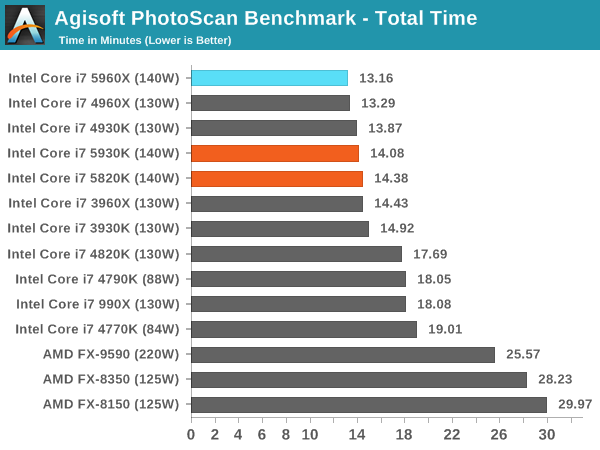
Photoscan's four separate components rely on different amounts of high frequency vs. many cores: check our Bench database for more detailed results but overall the 5960X comes out on top. That being said, the 5820K is less than 40% of the price and is only 1.2 minutes behind.
Dolphin Benchmark: link
Many emulators are often bound by single thread CPU performance, and general reports tended to suggest that Haswell provided a significant boost to emulator performance. This benchmark runs a Wii program that raytraces a complex 3D scene inside the Dolphin Wii emulator. Performance on this benchmark is a good proxy of the speed of Dolphin CPU emulation, which is an intensive single core task using most aspects of a CPU. Results are given in minutes, where the Wii itself scores 17.53 minutes.
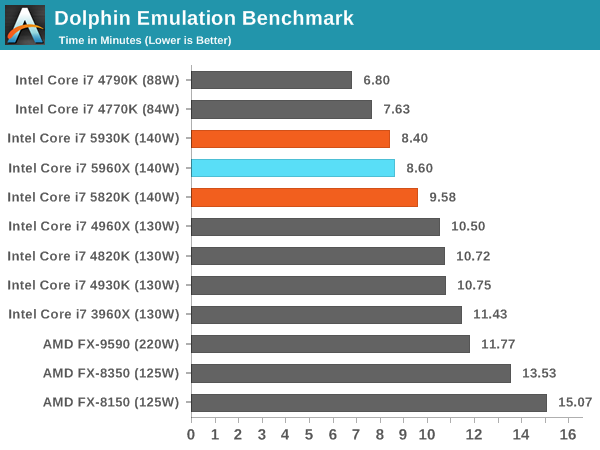
Dolphon loves single core speed and efficiency, meaning the 4790K wins out again. Interestingly the large L3 cache of the 5960X also helps here against the 5820K, despite the 5820K having a higher single thread frequency.
WinRAR 5.0.1: link
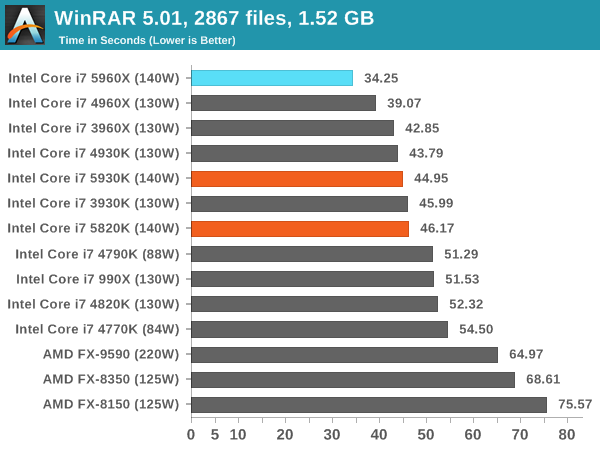
WinRAR is a variable thread workload, but more cores still wins out. Interestingly the xx60X CPUs are ahead of the xx30K CPUs followed by the xx20K. After this comes the 4790K, and then the 990X on par, showing how far three generations of Intel CPU have developed.
PCMark8 v2 OpenCL
A new addition to our CPU testing suite is PCMark8 v2, where we test the Work 2.0 and Creative 3.0 suites in OpenCL mode.
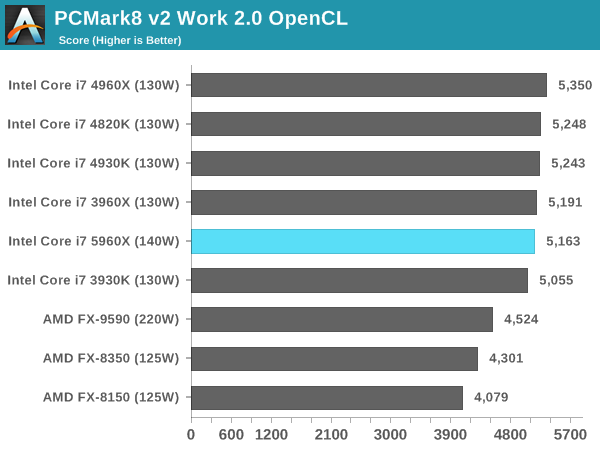
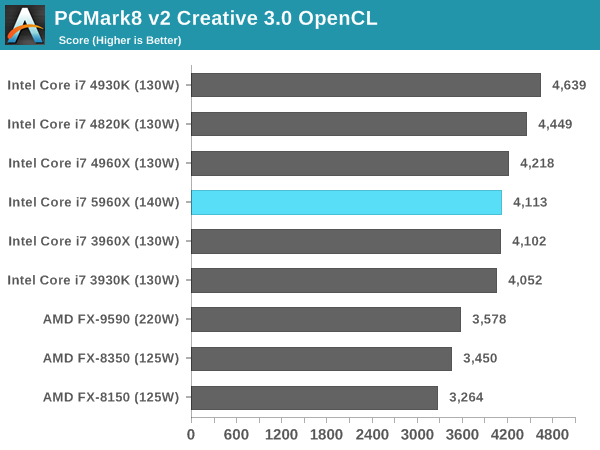
PCMark v8 relies on a number of factors, and it would seem that frequency is preferred over cache and memory. Interestingly the 4930K beat the 4960X in the Creative Suite with no obvious explanation.
Hybrid x265: link
Hybrid is a new benchmark, where we take a 4K 1500 frame video and convert it into an x265 format without audio. Results are given in frames per second.

Converting 4K video gets another step in the preference for more cores in Hybrid x265. The 5820K matches the 3960X, showing the progression of CPU generational development.
Cinebench R15
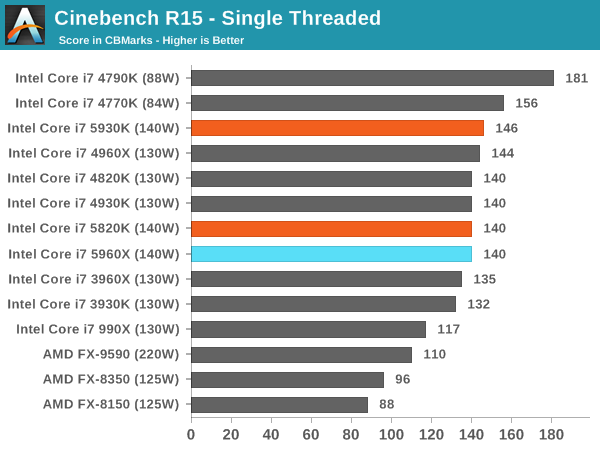
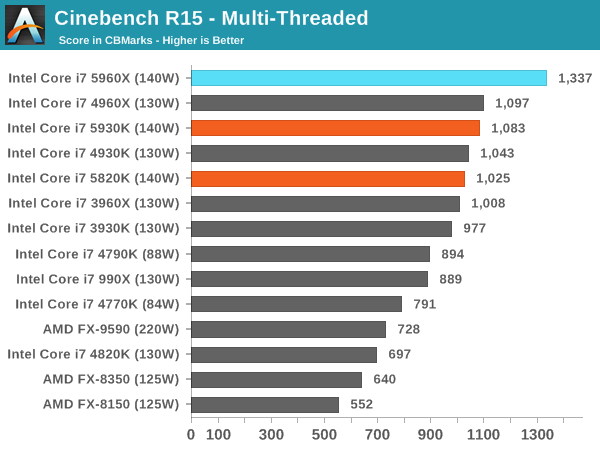
3D Particle Movement
3DPM is a self-penned benchmark, taking basic 3D movement algorithms used in Brownian Motion simulations and testing them for speed. High floating point performance, MHz and IPC wins in the single thread version, whereas the multithread version has to handle the threads and loves more cores.
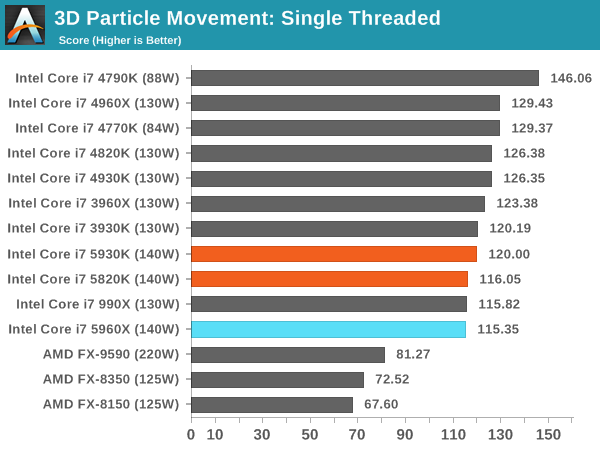

FastStone Image Viewer 4.9
FastStone is the program I use to perform quick or bulk actions on images, such as resizing, adjusting for color and cropping. In our test we take a series of 170 images in various sizes and formats and convert them all into 640x480 .gif files, maintaining the aspect ratio. FastStone does not use multithreading for this test, and results are given in seconds.
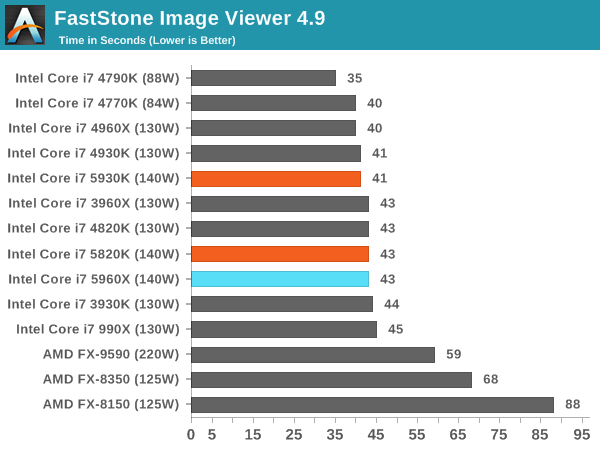
FastStone is a purely single threaded exercise, showing here how the lower core CPUs with high turbo perfom best, and by quite a margin.










203 Comments
View All Comments
wallysb01 - Saturday, August 30, 2014 - link
This really only makes sense if you don’t have “real” work to do on your computer. Or you only have work that utilizes 1-2 cores. Look at how these bench marks stack up against the 5960: http://www.anandtech.com/bench/product/47?vs=1317. For single threaded stuff its 20-30% faster and for multithreaded stuff its around 3x faster.That’s HUGE if you’re actually putting your computer through a tough workload. Instead of something finishing in month it finishes in 10 days? You don’t think that’s worth it?
And with the i7-920, are you on a motherboard with SATA III, or do you have PCIe expansion for SATA III. For those I/O limited, SATA III with a couple of striped SSDs is a tremendous improvement. Over what was around 5 years ago.
TonyZ - Sunday, August 31, 2014 - link
Same here, run my 2500K at 4.2 on air and I just haven't seen any reason to upgrade as of yet and I've been running it for near 3 years now.... We need something new and groundbreaking...chinmi - Sunday, August 31, 2014 - link
came here to say that :)it may be 10% slower, but it's 90% cheaper.
TiGr1982 - Tuesday, September 2, 2014 - link
These are different classes of hardware even for considerab=bly different purposes.It's like reading the review of Escalade and saying then, "I'll stick to my Focus then" :)
TiGr1982 - Tuesday, September 2, 2014 - link
I meant, comparison of 2500K and Haswell-E is like comparing Escalade and Focus.Crazy forum engine; AT really should look around, notice that better forums are on the web for 10+ years, and ask some web developer to make a normal forum (and not like a student alpha version course project). It's a bit of a shame for such a good website. Sorry for abruptness, but this is indeed the case.
Stas - Wednesday, September 3, 2014 - link
Likewise. 4.4Ghz is plenty. Lived through video card upgrades and still GPU limited with HD7950 o/c.Stas - Wednesday, September 3, 2014 - link
*3 video card upgradesq2klepto - Monday, September 8, 2014 - link
Yup - thankfully new games are almost completely limited by the GPU at high resolutions/quality (1440p/High+). I think my i7 2600k@4.7Ghz and R9 290X can last another year at least, and i can afford to put it underwater instead of upgrading.For normal desktop use, an SSD and 8GB+ of ram will burn thru everything without a prob
imaheadcase - Friday, August 29, 2014 - link
Correction? I think you mean "also featuring 6 cores""The entry level model is a slightly slower i7-5820K, also featuring eight cores and DDR4-2133 support. The main difference here is that it only has 28 PCIe 3.0 lanes. When I first read this, I was relatively shocked, but if you consider it from a point of segmentation in the product stack, it makes sense."
Ian Cutress - Friday, August 29, 2014 - link
Corrected :)